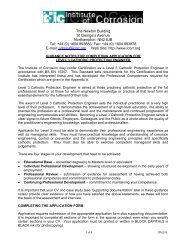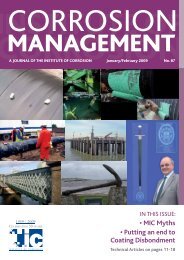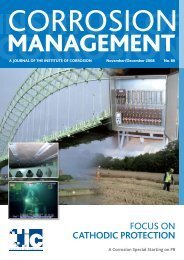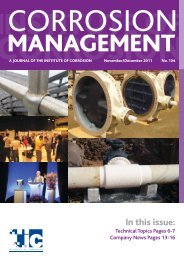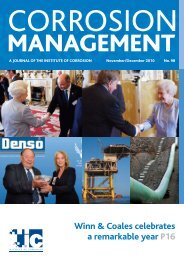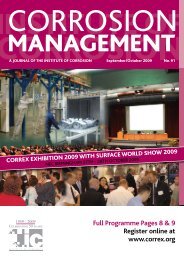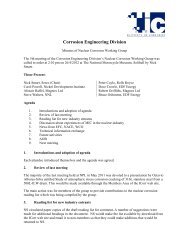In this issue: - the Institute of Corrosion
In this issue: - the Institute of Corrosion
In this issue: - the Institute of Corrosion
Create successful ePaper yourself
Turn your PDF publications into a flip-book with our unique Google optimized e-Paper software.
TECHNICALARTICLEn Splash Zone: The splash zone is locatedbetween <strong>the</strong> tidal and marine atmosphericzones (i.e. above mean high-water);n Tidal and Low Water Zones: Tidal zone liesbetween <strong>the</strong> mean low water and meanhigh-water tidesn Submerged Zone: This is <strong>the</strong> zone that liesbetween <strong>the</strong> seabed level (includingscouring zone) and 600mm -700mm below<strong>the</strong> mean low water; andn Below <strong>the</strong> seabed level: Where structure isbelow <strong>the</strong> seabed-level.2.1.3.4.1<strong>Corrosion</strong> inAtmospheric ZoneThis is <strong>the</strong> area between <strong>the</strong> top <strong>of</strong> <strong>the</strong>structure and <strong>the</strong> splash zone. The corrosion<strong>of</strong> an unprotected steel structures in <strong>this</strong> zoneis generally less than in <strong>the</strong> splash zone (Figure8) but it is still significant. The corrosionand degree <strong>of</strong> severity in <strong>the</strong> atmosphericzone depends on several variables such ashumidity, temperature, chloride content, windand sunlight 32 . For example saline particlesin <strong>the</strong> atmospheric zone accelerate metalliccorrosion process as chloride increases <strong>the</strong>solubility <strong>of</strong> <strong>the</strong> corrosion products. It is alsoreported that marine chloride dissolved in <strong>the</strong>layer <strong>of</strong> moisture also raises <strong>the</strong> conductivity<strong>of</strong> <strong>the</strong> electrolyte layer on <strong>the</strong> metal andtends to destroy <strong>the</strong> passive film existing on<strong>the</strong> metallic surface 33 . Recent study has alsodemonstrated that bacteria are involved in<strong>the</strong> longer term corrosion <strong>of</strong> mild steel in <strong>the</strong>atmospheric zone. 342.1.3.4.2 <strong>Corrosion</strong> inSplash Zone and BelowWaterlineA common localised and aggressive type <strong>of</strong>corrosion that occurs in splash zone and belowwaterline is defined as Accelerated Low Water<strong>Corrosion</strong> (ALWA) and its existences wasn’twidely recognised until 1980s 30 . ALWA (Figure8) is aggressive and localised and occurs on<strong>the</strong> surface <strong>of</strong> steel maritime structures in <strong>the</strong>tidal zones 30 .The detailed mechanism <strong>of</strong> ALWC is still notvery clear and continues to be a matter <strong>of</strong>some debate 3 & 30 but it is said it is to be oneform <strong>of</strong> Microbiologically <strong>In</strong>fluenced <strong>Corrosion</strong>(MIC) 3 & 30 also known as microbial corrosionor biological corrosion. It is <strong>the</strong> deterioration<strong>of</strong> metals as a result <strong>of</strong> <strong>the</strong> metabolic activity<strong>of</strong> microorganisms.Figure 8. <strong>Corrosion</strong> pr<strong>of</strong>ile <strong>of</strong> an unprotected steel structure in seawaterIt has been reported that when metal is firstimmersed in seawater, a thin biological slimefouling layer tends to develop in a matter<strong>of</strong> hours, which itself may influence <strong>the</strong>subsequent settlement <strong>of</strong> micro and macr<strong>of</strong>ouling organisms 35 . Following <strong>the</strong> micro-ormacro fouling organisms attachment, largedifferences in oxygen concentration or pHchanges can be created on metal surfaceswhich results in localised corrosion 36 .<strong>In</strong> general <strong>the</strong> intensity <strong>of</strong> corrosion <strong>of</strong> anunprotected steel structure in seawater variesmarkedly with position relative to <strong>the</strong> meanhigh and low tide level 37 as shown in figure8. It states that 37 <strong>the</strong> splash zone is <strong>the</strong> mostseverely attacked region due to continuouscontact with highly aerated sea water and<strong>the</strong> erosive effects <strong>of</strong> spray, waves and tidalactions.<strong>Corrosion</strong> in <strong>the</strong> idal zone (i.e. between MLWand MHW) is usually slow and uniform 3 . Thearea tends to accumulate dense barnaclegrowths with filamentous green seaweeds. Themarine growth does not corrode <strong>the</strong> materialbut makes <strong>the</strong> carbon steel more noble.<strong>Corrosion</strong> in <strong>the</strong> Low water zone is relativelysevere due to differential aeration at <strong>the</strong>uppermost point <strong>of</strong> continuous steelimmersion, where electrolyte is permanentand oxygen levels peak 3 , as well as that <strong>the</strong>low water zone is acting anodic relative to <strong>the</strong>tidal zone.The area approximately 500mm below meanlow water, where severe corrosion rates are<strong>of</strong>ten experienced is subject to AcceleratedLow Water <strong>Corrosion</strong> (ALWC) and PIANC 3summaries <strong>the</strong> corrosion mechanism <strong>of</strong> ALWCby stating that ALWC occurs in <strong>the</strong> presence<strong>of</strong> sulphates in marine environments, whichare converted by sulphate-reducing bacteria(SRB) into hydrogen sulphide (H2S) thatcauses direct anaerobic corrosion <strong>of</strong> steelsurfaces. The H2S generated in <strong>this</strong> metabolicprocess also serves as a food source for23



